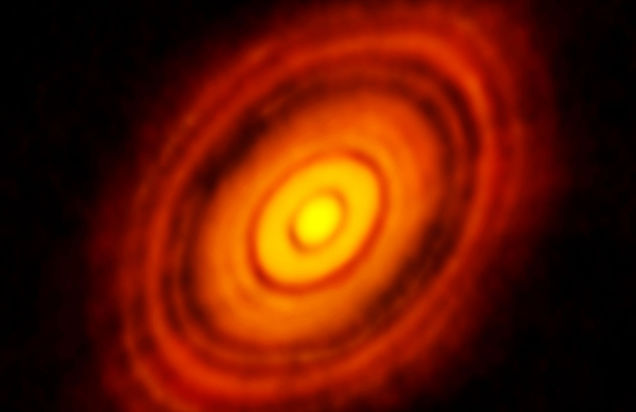We reach more than 65,000 registered users in Dec!! Register Now

Astrophysicists capture first image of planet being formed
- May 09, 2015
- 1079 Views
- 0 Likes
- 0 Comment
A recent and famous image from deep space is the first that shows planets forming, according to a study. Astrophysicists led by Daniel Tamayo of the University of Toronto concluded that fledgling planets explain circular gaps in a disk of dust and gas swirling around a young star called HL Tau. It ...
A recent and famous image from deep space is the first that shows planets forming, according to a study.
Astrophysicists led by Daniel Tamayo of the University of Toronto concluded that fledgling planets explain circular gaps in a disk of dust and gas swirling around a young star called HL Tau.
It “likely represents the first image taken of the initial locations of planets during their formation,” said Tamayo. “This could be an enormous step forward in our ability to understand how planets form.”
The image, taken last October by the Atacama Large Millimeter/submillimeter Array in Chile's Atacama Desert, sparked a debate from the beginning over whether it showed planets forming.
If planets are there, they're too small to be made out directly. Rather, their effects are visible as they clear out objects in the gaps through their gravity.
Some suggested that the gaps, especially the outer three, couldn't represent planets because they are too close together. Some also argued that planets massive enough to carve such gaps should be scattered by the force of gravity and tossed out of the system.
Tamayo's study instead suggests the gaps are evidence of planetary formation because the distances between them are consistent with what's called a special resonant configuration. In other words, these planets avoid crashing into each other by having specific orbital periods, or lengths of time per orbit, so that they miss each other. This is similar to how Pluto has avoided Neptune for billions of years even though their orbits cross.
Tamayo created two videos to show how HL Tau would look in both “resonant” and “non-resonant” configurations. The system can be much more stable in a resonant configuration and it's a natural state to which planets in the HL Tau system can migrate, said Tamayo.
The system is estimated as less than a million years old and about 36 billion km (22 billion miles) wide. It resides in the direction of the constellation Taurus 450 light-years from Earth. A light-year is the distance light travels in a year.
Since a thick shroud of dust and gas envelops young systems like HL Tau, they can't be seen using visible light. ALMA solves that by using a series of telescopes that pick up lower-energy light, which gets through the fog.
“We've discovered thousands of planets around other stars and a big surprise is that many of the orbits are much more elliptical than those found in our solar system,” said Tamayo. This and future ALMA discoveries may be the key to connecting these newfound planets to their original birth locations, he added.
While the HL Tau system remains stable in its relatively young age, Tamayo said over billions of years it will act as a “ticking time bomb.” Eventually the planets will scatter, ejecting some and leaving the remaining bodies on elliptical orbits like the ones found around older stars.
Our solar system doesn't seem to have undergone such a dramatic scattering, said Tamayo, but might be unusual in that respect. “If further observations show these to be the typical starting conditions around other stars, it would reveal our solar system to be a remarkably special place,” he added.
The findings are to be published in the upcoming edition of Astrophysical Journal.
source : http://www.world-science.net









